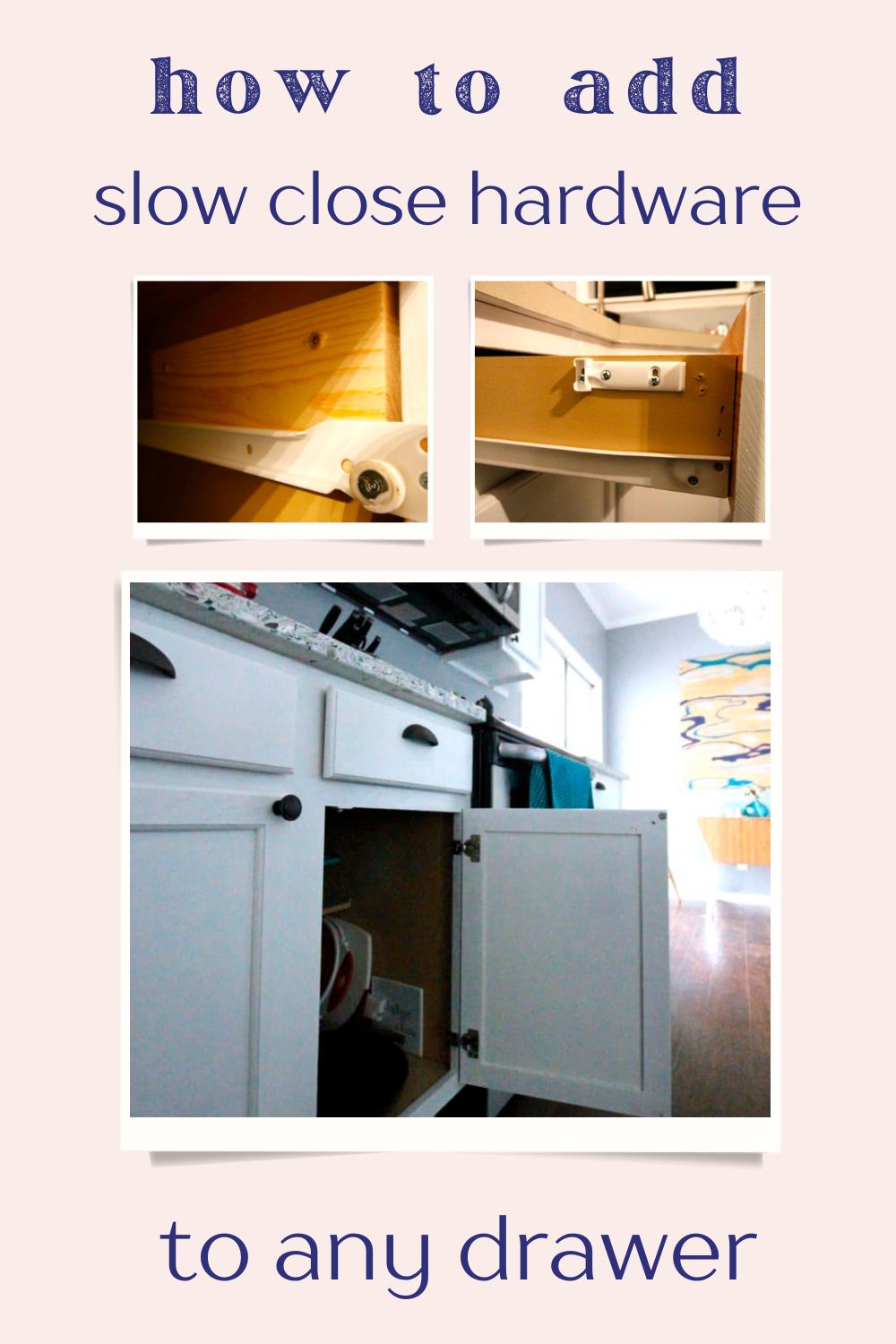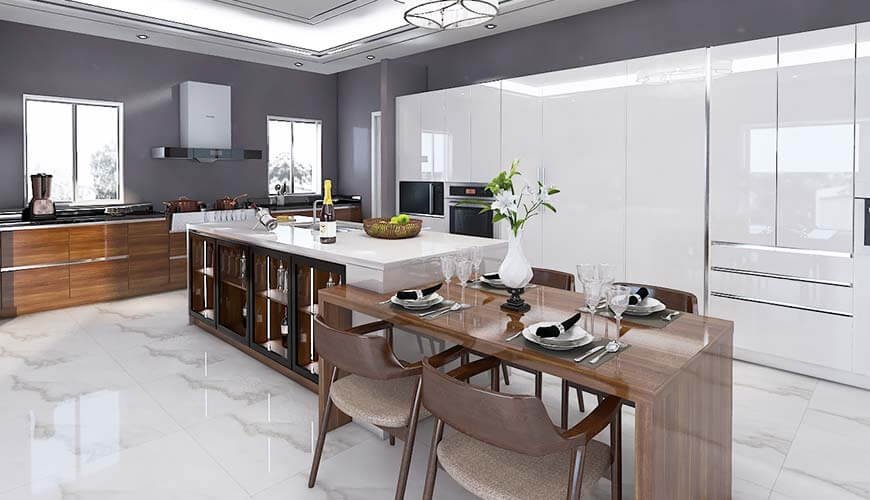To make kitchen cabinets soft close, install soft-close hinges or dampers. These devices prevent slamming and ensure a gentle close.
Kitchen cabinets often experience wear and tear due to frequent use. Soft-close mechanisms help extend their lifespan by reducing impact. They also enhance the overall kitchen experience by eliminating noise from slamming doors and drawers. Installing soft-close hinges or dampers is straightforward and can be done as a DIY project.
Most hardware stores offer these mechanisms in various styles to fit different cabinet types. Switching to soft-close cabinets improves functionality and adds a touch of luxury to your kitchen. This upgrade is a simple yet effective way to modernize your space.

Credit: www.charlestoncrafted.com
Table of Contents
ToggleTools And Materials
Transforming your kitchen cabinets into soft close cabinets can be simple. This guide will help you gather the right tools and materials. Let’s dive into what you need.
Essential Tools
Having the right tools is crucial for a smooth installation. Here are the essential tools you need:
- Screwdriver – A Phillips head screwdriver will work best.
- Drill – A cordless drill is recommended for ease of use.
- Measuring Tape – Accuracy is key, so a measuring tape is essential.
- Pencil – Useful for marking points for screws.
Required Materials
Gathering the necessary materials will make the process easier. Here’s what you’ll need:
- Soft Close Hinges – The main component for the upgrade.
- Screws – Ensure you have the correct size for your hinges.
- Mounting Plates – These help in securing the hinges.
- Cabinet Bumpers – Optional, but they help in reducing noise.
Below is a handy table summarizing the tools and materials:
| Tools | Materials |
|---|---|
| Screwdriver | Soft Close Hinges |
| Drill | Screws |
| Measuring Tape | Mounting Plates |
| Pencil | Cabinet Bumpers |
Preparation
Before installing soft-close mechanisms on your kitchen cabinets, proper preparation is key. This ensures a smooth process and optimal results. Follow these steps to get your cabinets ready for the upgrade.
Clear Out Cabinets
First, remove all items from your cabinets. This includes dishes, utensils, and food. Clearing the space makes it easier to work and prevents any damage.
Place your items on a nearby table or counter. This keeps them within reach but out of the way. Use this opportunity to clean the inside of your cabinets.
Measure And Mark
Next, measure the dimensions of your cabinet doors and frames. Use a measuring tape for accuracy. Note the measurements on a piece of paper.
Then, mark the spots where you will install the soft-close mechanisms. Use a pencil to make small, visible marks. These marks guide you during installation.
Avoid guessing the placement. Precise measurements ensure the soft-close mechanisms work correctly.
Removing Old Hinges
To make your kitchen cabinets soft close, you must first remove old hinges. This step is crucial for a smooth installation of soft close hinges. Follow these steps to safely and efficiently remove old hinges from your kitchen cabinets.
Safely Remove Doors
Before you start, gather these tools:
- Phillips screwdriver
- Flathead screwdriver
- Drill (optional)
- Step stool (if needed)
Use the step stool to reach higher cabinet doors. Open the cabinet door fully. Use the Phillips screwdriver to unscrew the top hinge first. Support the door with one hand while unscrewing. Repeat for the bottom hinge. Carefully lift the door off the cabinet.
Detach Existing Hinges
Once the door is off, lay it flat on a sturdy surface. Use the Phillips screwdriver to remove screws from the old hinges. If the screws are tight, use a drill for easier removal. Place the old hinges and screws in a small container.
Inspect the cabinet frame where the hinges were attached. Clean any debris or dust with a cloth. This ensures the new soft close hinges fit properly.
Installing Soft Close Hinges
Upgrading your kitchen cabinets to soft close hinges is a game-changer. It stops those annoying slams and extends the life of your cabinets. Follow these steps to install soft close hinges yourself.
Align New Hinges
First, remove the old hinges. Use a screwdriver to unscrew them. Keep the screws handy for later use.
Next, take your new soft close hinges. Align them with the existing holes on the cabinet door. Check that they fit snugly. If the holes don’t match, mark new spots using a pencil.
| Step | Action |
|---|---|
| 1 | Remove old hinges |
| 2 | Align new hinges |
| 3 | Mark new holes if needed |
Secure Hinges In Place
Now, it’s time to secure the new hinges. Use the screws you saved earlier. If you marked new spots, drill pilot holes first. This makes screwing in easier.
Hold the hinge in place. Insert the screws and tighten them. Do not overtighten, as it can damage the cabinet door.
- Hold hinge in place
- Insert screws
- Tighten screws carefully
Finally, test the door. It should close softly without slamming. Adjust the hinges if necessary for a perfect fit.
Adjusting Hinges
Adjusting hinges is a key step to make your kitchen cabinets soft close. Properly aligned hinges ensure smooth operation and prevent damage. Follow these steps to fine-tune alignment and test the soft close mechanism.
Fine-tuning Alignment
First, locate the adjustment screws on your cabinet hinges. There are usually three types of screws:
- Horizontal adjustment screws move the door left or right.
- Vertical adjustment screws move the door up or down.
- Depth adjustment screws move the door in or out.
Use a screwdriver to turn these screws. Adjust them one at a time:
- Start with the horizontal adjustment screw. Turn it slowly to align the door.
- Next, adjust the vertical screw. Ensure the door is level with the cabinet frame.
- Finally, use the depth adjustment screw. Make sure the door is flush with the cabinet.
Testing Soft Close Mechanism
After adjusting the hinges, test the soft close mechanism:
- Gently push the cabinet door closed.
- Observe if the door closes smoothly and silently.
- If the door slams, adjust the soft close damper.
Most soft close hinges have a damper adjustment screw. Turn this screw to increase or decrease resistance:
| Action | Result |
|---|---|
| Turn clockwise | Increases resistance |
| Turn counterclockwise | Decreases resistance |
Repeat the process until the door closes perfectly. Your kitchen cabinets are now soft close!

Credit: www.youtube.com
Installing Soft Close Dampers
Installing soft close dampers can make your kitchen quieter. The doors won’t slam shut anymore. Follow these steps to install them properly.
Positioning Dampers
First, you need to position the dampers. Open the cabinet door fully. Find the inside top corner of the cabinet. This is where you will attach the damper. Make sure it’s aligned with the door’s edge.
Attaching Dampers
Next, use screws to attach the damper. Hold the damper in place. Use a screwdriver to secure it. Ensure the damper is tightly attached. Close the door to test it. Adjust if necessary.
| Steps | Details |
|---|---|
| 1 | Open the cabinet door fully. |
| 2 | Position the damper in the top corner. |
| 3 | Align it with the door’s edge. |
| 4 | Screw the damper in place. |
| 5 | Test by closing the door. |
| 6 | Adjust if necessary. |
Tip: Use a power drill for faster attachment.
Final Touches
The final touches are crucial for your kitchen cabinets. They ensure your cabinets perform perfectly and look professional. This step includes reattaching cabinet doors and checking overall functionality. Let’s dive into these final steps.
Reattach Cabinet Doors
Reattaching cabinet doors is simple yet vital. Begin by aligning the hinges with the pre-drilled holes. Use a screwdriver to secure the screws tightly.
Ensure the doors are level. An uneven door can disrupt the soft-close mechanism. Use a spirit level to check the alignment.
Use the following tools:
- Screwdriver
- Spirit level
- Drill (if needed)
Once aligned, test the door for smooth opening and closing. If adjustments are needed, loosen the screws slightly and reposition the door.
Check Overall Functionality
Now, test the overall functionality of your kitchen cabinets. Open and close each door to ensure the soft-close mechanism works.
Checklist for checking functionality:
- Ensure doors close quietly.
- Check for any resistance while closing.
- Ensure all doors are level and aligned.
If any door does not close softly, adjust the hinges. A minor tweak can make a significant difference.
Additional Tips:
- Lubricate hinges if they feel stiff.
- Tighten all screws to avoid loose fittings.
These final touches ensure your kitchen cabinets are perfect. Enjoy the smooth and quiet operation of your newly upgraded cabinets!
Maintenance Tips
Keeping your kitchen cabinets in top condition ensures they last long. Soft close mechanisms need regular attention to function well. Follow these maintenance tips to keep your cabinets working smoothly.
Regular Inspections
Perform regular inspections to catch any issues early. Check the hinges and dampers every few months. Look for signs of wear and tear. Tighten any loose screws with a screwdriver.
Use a flashlight to inspect dark corners. Make sure the cabinet doors align properly. Misaligned doors can cause stress on the soft close mechanism. Adjust the hinges if needed.
Troubleshooting Common Issues
Soft close mechanisms can sometimes malfunction. Here are some common problems and their solutions:
| Issue | Solution |
|---|---|
| Cabinet door slams shut | Adjust the damper settings. |
| Door doesn’t close fully | Check for obstructions and adjust hinges. |
| Hinges make noise | Lubricate the hinges with WD-40. |
If the door slams shut, the damper might be set too low. Adjust the damper by turning the screw. If the door doesn’t close fully, look for any obstructions. Adjust the hinges to ensure proper alignment.
Noisy hinges often need lubrication. Use WD-40 to lubricate the hinges. Spray a small amount on the hinge and move the door back and forth.

Credit: porchdaydreamer.com
Frequently Asked Questions
What Are Soft Close Kitchen Cabinets?
Soft close kitchen cabinets have hinges that prevent slamming, ensuring a smooth, quiet close.
Why Install Soft Close Hinges?
Soft close hinges prevent noise, reduce wear and tear, and provide a premium feel to cabinets.
How Do Soft Close Hinges Work?
Soft close hinges use hydraulic mechanisms to slow the door’s movement, ensuring a gentle, quiet close.
Are Soft Close Hinges Expensive?
Soft close hinges are affordable and offer great value given their benefits in noise reduction and durability.
Can I Install Soft Close Hinges Myself?
Yes, installing soft close hinges is a simple DIY task. Basic tools and a little patience are all you need.
Do Soft Close Hinges Fit All Cabinets?
Most soft close hinges are designed to fit standard cabinet doors. Always check compatibility before purchasing.
What Tools Are Needed For Installation?
You’ll need a screwdriver, a drill, and a measuring tape to install soft close hinges on your cabinets.
How Long Does Installation Take?
Installing soft close hinges typically takes about 10-15 minutes per cabinet door.
Are Soft Close Hinges Adjustable?
Yes, many soft close hinges are adjustable, allowing you to fine-tune the closing speed and alignment.
Where To Buy Soft Close Hinges?
Soft close hinges are available at hardware stores, home improvement centers, and online retailers like Amazon.
Conclusion
Soft-close kitchen cabinets enhance your cooking experience. They prevent slamming and extend the life of your cabinets. Following these simple steps ensures a smoother, quieter kitchen. Enjoy the benefits of a peaceful home environment with this easy DIY project. Upgrade your kitchen today for a more modern and functional space.


